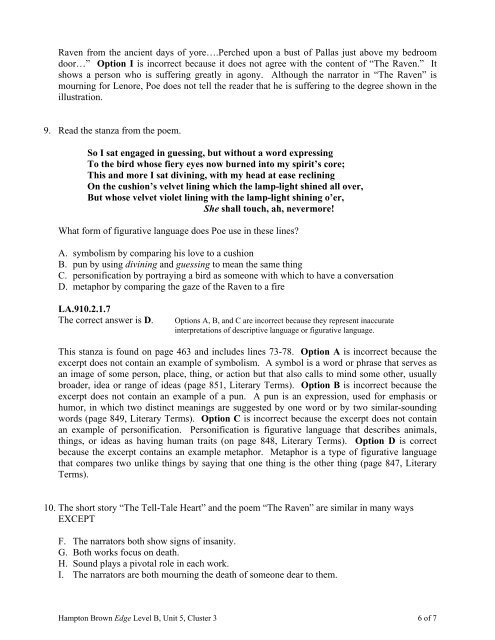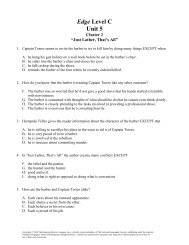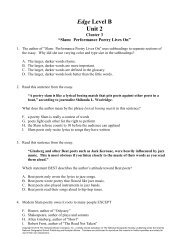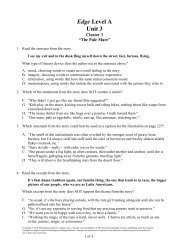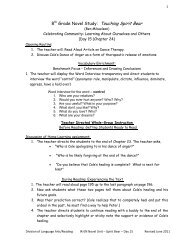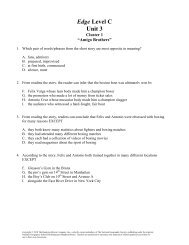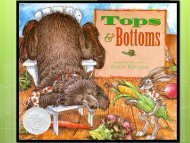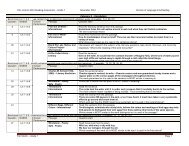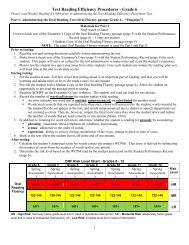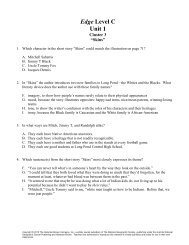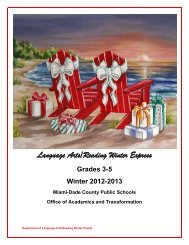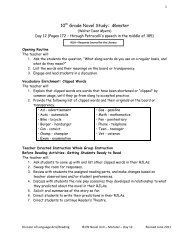Edge Level B Unit 5 - Division of Language Arts/Reading
Edge Level B Unit 5 - Division of Language Arts/Reading
Edge Level B Unit 5 - Division of Language Arts/Reading
You also want an ePaper? Increase the reach of your titles
YUMPU automatically turns print PDFs into web optimized ePapers that Google loves.
Raven from the ancient days <strong>of</strong> yore….Perched upon a bust <strong>of</strong> Pallas just above my bedroom<br />
door…” Option I is incorrect because it does not agree with the content <strong>of</strong> “The Raven.” It<br />
shows a person who is suffering greatly in agony. Although the narrator in “The Raven” is<br />
mourning for Lenore, Poe does not tell the reader that he is suffering to the degree shown in the<br />
illustration.<br />
9. Read the stanza from the poem.<br />
So I sat engaged in guessing, but without a word expressing<br />
To the bird whose fiery eyes now burned into my spirit’s core;<br />
This and more I sat divining, with my head at ease reclining<br />
On the cushion’s velvet lining which the lamp-light shined all over,<br />
But whose velvet violet lining with the lamp-light shining o’er,<br />
She shall touch, ah, nevermore!<br />
What form <strong>of</strong> figurative language does Poe use in these lines?<br />
A. symbolism by comparing his love to a cushion<br />
B. pun by using divining and guessing to mean the same thing<br />
C. personification by portraying a bird as someone with which to have a conversation<br />
D. metaphor by comparing the gaze <strong>of</strong> the Raven to a fire<br />
LA.910.2.1.7<br />
The correct answer is D.<br />
Options A, B, and C are incorrect because they represent inaccurate<br />
interpretations <strong>of</strong> descriptive language or figurative language.<br />
This stanza is found on page 463 and includes lines 73-78. Option A is incorrect because the<br />
excerpt does not contain an example <strong>of</strong> symbolism. A symbol is a word or phrase that serves as<br />
an image <strong>of</strong> some person, place, thing, or action but that also calls to mind some other, usually<br />
broader, idea or range <strong>of</strong> ideas (page 851, Literary Terms). Option B is incorrect because the<br />
excerpt does not contain an example <strong>of</strong> a pun. A pun is an expression, used for emphasis or<br />
humor, in which two distinct meanings are suggested by one word or by two similar-sounding<br />
words (page 849, Literary Terms). Option C is incorrect because the excerpt does not contain<br />
an example <strong>of</strong> personification. Personification is figurative language that describes animals,<br />
things, or ideas as having human traits (on page 848, Literary Terms). Option D is correct<br />
because the excerpt contains an example metaphor. Metaphor is a type <strong>of</strong> figurative language<br />
that compares two unlike things by saying that one thing is the other thing (page 847, Literary<br />
Terms).<br />
10. The short story “The Tell-Tale Heart” and the poem “The Raven” are similar in many ways<br />
EXCEPT<br />
F. The narrators both show signs <strong>of</strong> insanity.<br />
G. Both works focus on death.<br />
H. Sound plays a pivotal role in each work.<br />
I. The narrators are both mourning the death <strong>of</strong> someone dear to them.<br />
Hampton Brown <strong>Edge</strong> <strong>Level</strong> B, <strong>Unit</strong> 5, Cluster 3 6 <strong>of</strong> 7


